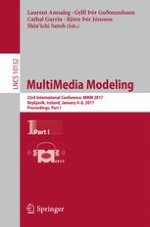The two-volume set LNCS 10132 and 10133 constitutes the thoroughly refereed proceedings of the 23rd International Conference on Multimedia Modeling, MMM 2017, held in Reykjavik, Iceland, in January 2017.
Of the 149 full papers submitted, 36 were selected for oral presentation and 33 for poster presentation; of the 34 special session papers submitted, 24 were selected for oral presentation and 2 for poster presentation; in addition, 5 demonstrations were accepted from 8 submissions, and all 7 submissions to VBS 2017. All papers presented were carefully reviewed and selected from 198 submissions.
MMM is a leading international conference for researchers and industry practitioners for sharing new ideas, original research results and practical development experiences from all MMM related areas, broadly falling into three categories: multimedia content analysis; multimedia signal processing and communications; and multimedia applications and services.
